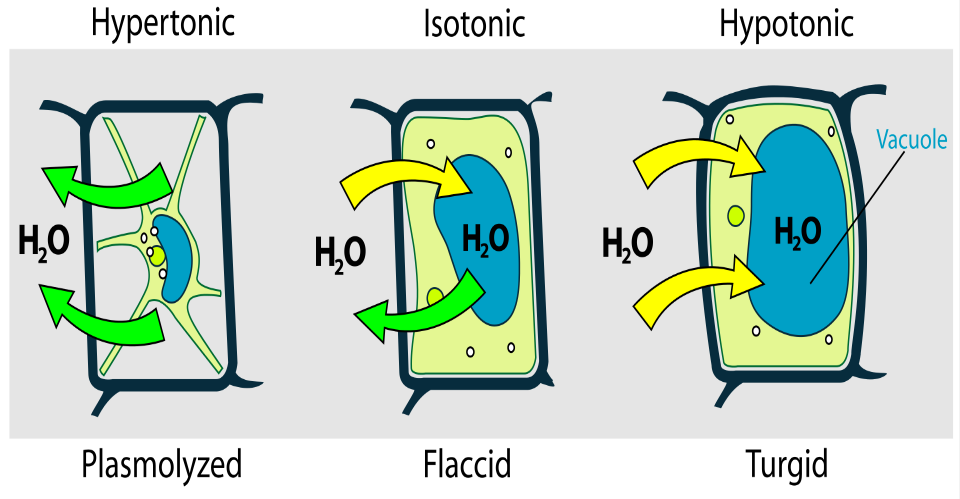
The shrinking of protoplasm in plant cell, is called as
A) Plasmolysis
B) Deplasmolysis
C) Flaccidity
D) Turgidity
Answer
507.6k+ views
Hint: Cytoplasm along with the nucleoplasm is known as the protoplasm. When the cell is placed in a hypertonic solution, the protoplasm of the cell shrinks due to outward movement of solvent from the cell to the surrounding. Due to the loss of turgor pressure, the protoplasmic membrane detaches from the cell wall.
Complete answer:
To solve this question, we must know the different types of movement of solvent molecules in the plant cell.
The plant cell comprises the outer layer of the cell wall and the protoplasm. When the plant cell is placed in a hypertonic solution, the exosmosis takes place that is the outward movement of the solvent molecules (region of higher concentration of solvent to the region of lower concentration). This shrinkage of the protoplasm is termed as plasmolysis. It is a very common phenomenon taking place at the guard cells in the leaf.
Deplasmolysis- It is opposite of plasmolysis. It means swelling of the protoplasm when the cell is placed in hypotonic solution.
Flaccidity- It is the condition of the cell that is placed in an isotonic solution. The cell does not have any turgor pressure and in this stake the cell shrinks but the plasma membrane is not pushed to the wall.
Turgidity- It is the condition of the cell when it contains a greater amount of fluid in the cell or the cell is in a swollen state.

The correct answer is A.
Note:
The solutions are of three types-
1. Isotonic- In which the solute concentration is equal to that of the solvent.
2. Hypotonic-In this the solute concentration is less than that of solvent.
3. Hypertonic- In this the solute concentration is greater than that of solvent.
Complete answer:
To solve this question, we must know the different types of movement of solvent molecules in the plant cell.
The plant cell comprises the outer layer of the cell wall and the protoplasm. When the plant cell is placed in a hypertonic solution, the exosmosis takes place that is the outward movement of the solvent molecules (region of higher concentration of solvent to the region of lower concentration). This shrinkage of the protoplasm is termed as plasmolysis. It is a very common phenomenon taking place at the guard cells in the leaf.
Deplasmolysis- It is opposite of plasmolysis. It means swelling of the protoplasm when the cell is placed in hypotonic solution.
Flaccidity- It is the condition of the cell that is placed in an isotonic solution. The cell does not have any turgor pressure and in this stake the cell shrinks but the plasma membrane is not pushed to the wall.
Turgidity- It is the condition of the cell when it contains a greater amount of fluid in the cell or the cell is in a swollen state.

The correct answer is A.
Note:
The solutions are of three types-
1. Isotonic- In which the solute concentration is equal to that of the solvent.
2. Hypotonic-In this the solute concentration is less than that of solvent.
3. Hypertonic- In this the solute concentration is greater than that of solvent.
Recently Updated Pages
Master Class 12 Business Studies: Engaging Questions & Answers for Success

Master Class 12 Economics: Engaging Questions & Answers for Success

Master Class 12 English: Engaging Questions & Answers for Success

Master Class 12 Maths: Engaging Questions & Answers for Success

Master Class 12 Social Science: Engaging Questions & Answers for Success

Master Class 12 Chemistry: Engaging Questions & Answers for Success

Trending doubts
What is meant by exothermic and endothermic reactions class 11 chemistry CBSE

Which animal has three hearts class 11 biology CBSE

10 examples of friction in our daily life

One Metric ton is equal to kg A 10000 B 1000 C 100 class 11 physics CBSE

1 Quintal is equal to a 110 kg b 10 kg c 100kg d 1000 class 11 physics CBSE

Difference Between Prokaryotic Cells and Eukaryotic Cells




